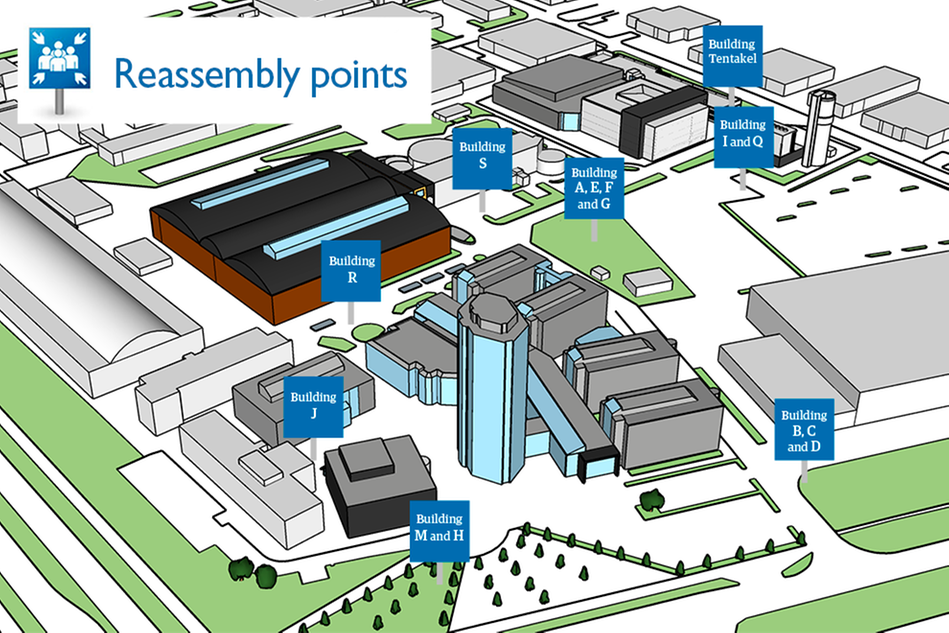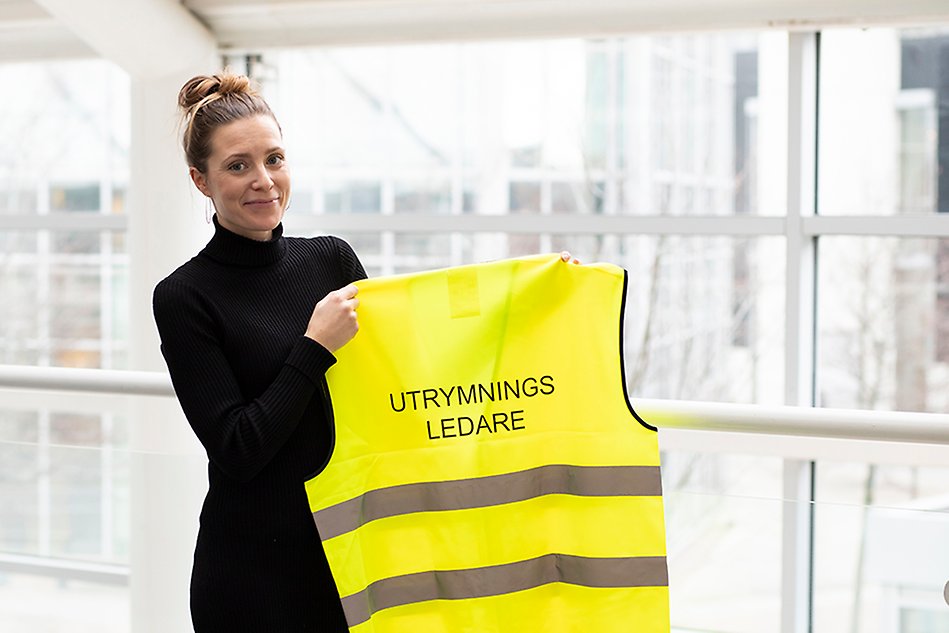Fire and evacuation
It's important that you know what procedures apply if a situation should arise when the premises of the university need to be evacuated, as in the case of a fire. On this page you find information about what you can do to be prepared for an emergency, as well as what you should do if an emergency arises.
Here’s how to prepare for an evacuation
- Make sure to be aware of the closest fire exit and fire-fighting equipment in the room you are located in.
- Find out where the evacuation plan is in the room where you are. Often the evacuation plan is found at the entrance of the building and on the inside of the toilet doors. Contents: brief information concerning escape routes, fire-fighting equipment, alarm devices, evacuation points, and what to do in an emergency.
- Make sure you know where the closest escape route in the building is.
- Find out where the safety vest and the evacuation card are in the room where you are.
- Find out where the nearest reassembly point is, so you know where to go in case of a fire alarm.
Here's what to do in case of a fire alarm
Always react seriously to a fire alarm. Escape the buildings and warn others. Below you find information about what to do if there is a fire alarm at Halmstad University:
- Alert and warn others. The University has automatic fire alarms in all buildings and automatic extinuishing systems for all buildings except in the J building, Visionen. If you detect a fire and the automatic fire alarm has not started – call for help via a fire alarm button or call 112.
- Take the role as evacuation leader. If you find yourself near a safety vest – put it on and become the evacuation leader. Safety vests and evacuation cards are available at all the University's entrances and exits, in all departments and on all floors.
- Save those in obvious danger.
- Extinguish the fire. Use the fire extinguishing equipment to extinguish the fire if you can do so without putting yourself or anyone else at risk.
- Leave the premises via the nearest fire exit. Leave the building as calmly but as quickly as possible. If the room is smoky – go down and crawl on the floor. Do not use a lift in the event of a fire alarm. If someone with a physical disability has difficulty getting to a safe place, help this person get to the nearest staircases and wait for the rescue services there. In the escape staircases the walls, ceilings and floors are built to withstand fire for a certain period of time.
- Go to the reassembly point. Wait for information, for example, when it is okay to enter the building again. Do you know that a colleague or student is still in the building? Inform the evacuation leader or rescue service just where the person is.
Fire drills take place regularly at the University. Always react seriously to a fire alarm. Evacuate the buildings and warn others.
Evacuation for those with a physical disability
During an evacuation, using the University's elevators is prohibited. If you have a disability that requires you to use a lift, you should get yourself to a safe place and wait there for help.
If you have a physical disability:
- Make your way as best you can to a safe place.
- Ask someone for help in notifying the evacuation leader or rescue services to tell them where you are.
- If you are alone, call 112 or call the University's on-call service and tell them where you are.
- Security number Campus Halmstad: 0046 35-299 10 30
- Security number Campus Varberg: 0046 10-2193000
If you have a fellow student who has a physical disability:
- Help this person, if they need help, to get to a safe place.
- Tell the evacuation leader or rescue services where the person is.
Safe escape routes at campus
- Escape staircases where the walls, ceilings and floors are built to withstand fire for a certain period of time. Wait here until the rescue services arrive.
- On one of the landings on the external staircase. Wait here until the rescue services arrive.
 Zoom image
Zoom imageClick on image to enlarge it. At the university, evacuation plans are to be found on all floors, at the entrances, project rooms as well as the toilets. On the evacuation plan, you see which reassembly point is associated to the building you are in. In an evacuation, the most important thing is that you DO evacuate and leave the premises – not that you come to the "correct" reassembly point.
Procedures to follow as an evacuation leader
- Make sure everyone (students, staff and visitors) make their way to one of the reassembly points outdoors.
- Mark on the evacuation card if you know of a room or area inside the building that is not yet evacuated, or if you know where a person may still be.
- Choose, in agreement with the other evacuation leaders, a coordinator. This person becomes the contact person for the rescue services. The coordinator then collects all the evacuation cards and hands them over to the rescue services.
- Make sure the rescue services have clear access for their vehicles and equipment.
- Make sure that everyone stays at the evacuating point outdoors and not enter the building until the rescue services has given the all clear.
All of tasks and procedures evacuation leaders need to follow are stated on the evacuation card found next to the safety vest on campus.

The yellow evacuation vest that the evacuation leader should use in case of emergency.
Contact
-
Eleonor Gullberg
-
Environment and Security Coordinator
-
In case of emergency
-
Security number Campus Halmstad
-
Security number Campus Varberg

